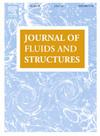Scattering of oblique incident waves by a rigid floating structure in the presence of two surface-piercing thick porous breakwaters: Pattern of reflection, dissipation and wave forces
IF 3.4
2区 工程技术
Q1 ENGINEERING, MECHANICAL
引用次数: 0
Abstract
The present work examines the wave interaction with a rigid floating structure, placed after two distinct porous structures, to mitigate wave-induced forces acting on the floating structure. The physical and mathematical consideration of the wave passing through these thick porous structures is based on the model devised by Sollitt and Cross (1972). Splitting the fluid domain into nine regions, the scattered potential in each region is obtained by setting up a system of equations using the relevant matching conditions across the boundaries. The behavior of the roots of the dispersion relation is analyzed to identify conditions under which the eigenfunction solution may become invalid. The graphs plotted for the reflection coefficient, transmission coefficient, dissipation coefficient, and wave-induced forces acting on the floating structure indicate several findings: (i) if the porosity of the second porous structure is less than that of the first porous structure, then the wave energy loss increases, thereby enhancing the safety of the floating structure through reduction of the forces, (ii) as the value of the friction factor of both breakwaters increases, the reflection coefficient decreases, (iii) by increasing the height and thickness of the breakwaters, more loss of wave energy can be achieved due to the dissipative nature of the porous structures. Consequently, the forces acting on the floating structure decrease, helping in its stability. The findings propose the appropriate values of different parameters for an efficient design of such porous breakwaters, as well as how they need to be located.
在两个穿透表面的厚多孔防波堤存在下,刚性浮动结构对斜入射波的散射:反射、耗散和波浪力的模式
目前的工作研究了波浪与刚性浮动结构的相互作用,放置在两个不同的多孔结构之后,以减轻作用在浮动结构上的波浪诱导力。通过这些厚多孔结构的波的物理和数学考虑是基于Sollitt和Cross(1972)设计的模型。将流体域划分为9个区域,利用边界上的相关匹配条件建立方程组,得到每个区域的散射势。分析了色散关系根的行为,以确定本征函数解可能失效的条件。反射系数、透射系数、耗散系数和作用在浮式结构上的波浪力的曲线图表明了以下几点发现:(1)如果第二多孔结构的孔隙度小于第一多孔结构的孔隙度,则波浪能损失增加,从而通过减小受力来增强浮式结构的安全性;(2)随着两个防波堤摩擦系数的增大,反射系数减小;(3)通过增加防波堤的高度和厚度,由于多孔结构的耗散特性,波浪能损失更多。因此,作用在浮动结构上的力减小,有助于其稳定性。研究结果为这种多孔防波堤的有效设计提出了不同参数的适当值,以及它们需要如何定位。
本文章由计算机程序翻译,如有差异,请以英文原文为准。
求助全文
约1分钟内获得全文
求助全文
来源期刊

Journal of Fluids and Structures
工程技术-工程:机械
CiteScore
6.90
自引率
8.30%
发文量
173
审稿时长
65 days
期刊介绍:
The Journal of Fluids and Structures serves as a focal point and a forum for the exchange of ideas, for the many kinds of specialists and practitioners concerned with fluid–structure interactions and the dynamics of systems related thereto, in any field. One of its aims is to foster the cross–fertilization of ideas, methods and techniques in the various disciplines involved.
The journal publishes papers that present original and significant contributions on all aspects of the mechanical interactions between fluids and solids, regardless of scale.
 求助内容:
求助内容: 应助结果提醒方式:
应助结果提醒方式:


